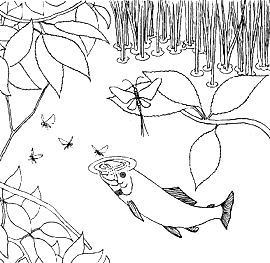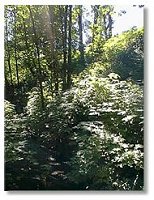WATER TEMPERATURE
Vegetation around a stream keeps the water cool.
Cool water is important for healthy fish.
Whether it be in the stream or near it, vegetation is an extremely important part of healthy
fish habitat. One of the most important roles vegetation plays is in providing shade for the
streams and rivers in order to keep the water cool. Fish need their water to be between 3 and 11
degrees Celsius for them to be comfortable. The less vegetation around a stream, the more
sunlight can penetrate the water.
This may cause temperatures to become too high for fish to survive. The minimum amount of
vegetation adjacent to a stream should be an area at least 30 meters wide to be considered
adequate.

SHELTER
Vegetation protects salmon from being seen by
predators.
Another crucial role vegetation plays is in providing shelter from predators. Fish can often
be found hiding in sedges and under branches where they won't be spotted by birds, larger fish,
or other predators. Even large trees and shrubs help protect fish in the stream. If a bird such as a
osprey happens to spot a fish in the water, it may not be able to safely dive down to the stream
and return to the sky if there is too much vegetation in the way.
FOOD SOURCE
Insects that live on the vegetation often fall into the water,
and are eaten by the salmon.

Although only a minor source of a salmon's food, vegetation is also home to many insects
and larvae which salmon feed on. The number of insects that fall into the water is directly
related to the amount of vegetation covering the stream. More vegetation over a stream means
more insects falling into the water, providing added food for growing coho fry.
BANK STABILITY

Vegetation is needed to hold the stream banks together.
This is important because we don't want silt to get into the stream.
Trees and shrubs also help to stabilize stream banks. The roots from this riparian vegetation help hold the soil in the stream banks, and prevent it
from being eroded and washed away with the fast moving waters.
NUTRIENTS*
Small pieces of vegetation eventually become nutrients to a stream and its animals.
Finally, small pieces of leaves and branches that fall into the stream eventually decompose
and provide valuable nutrients for the system. These nutrients, which can be called detritus, will
nourish many small organisms called collectors, which are, in
turn, a valuable food source for salmon and other animals.
Controlling water temperatures, providing fish with safe shelter and a steady food supply,
and maintaining stream bank stability are the most important functions of stream
vegetation.
Top of page.

